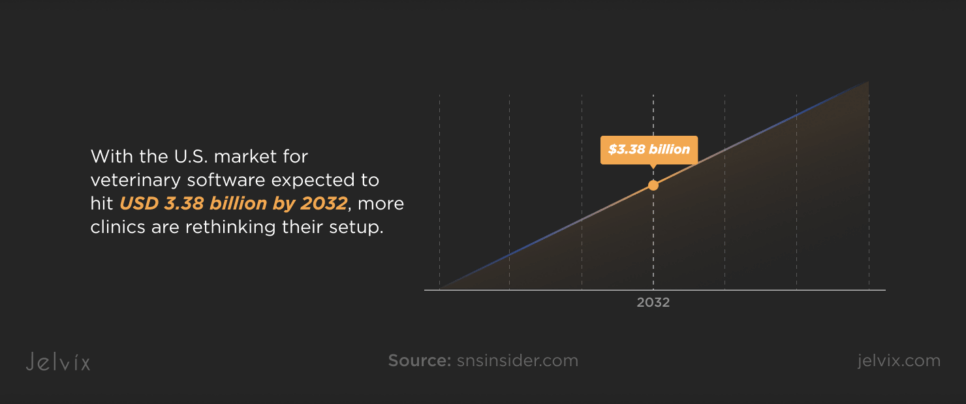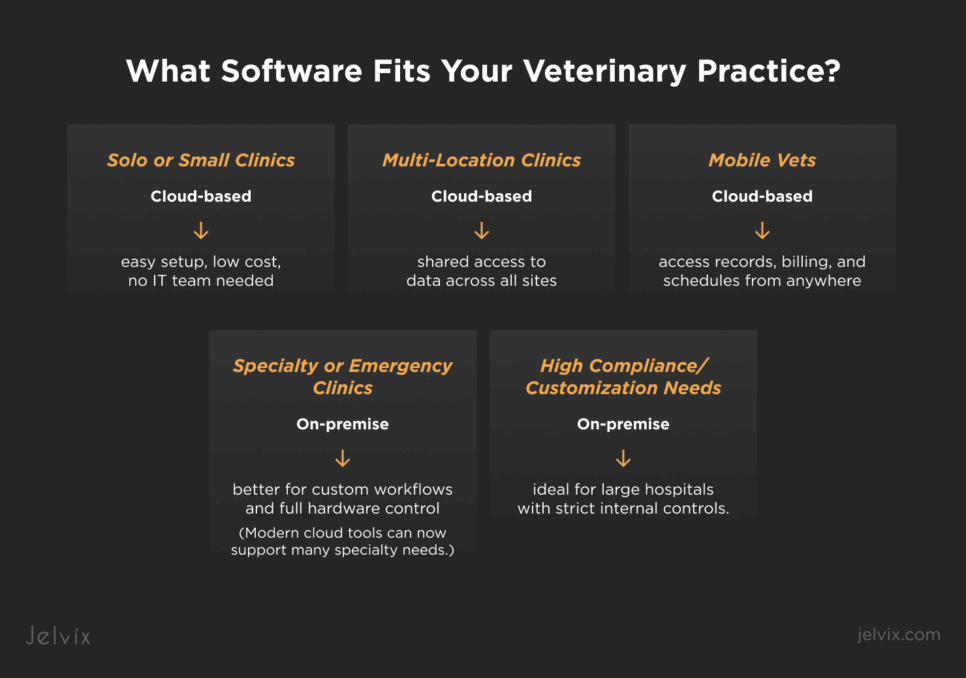With the U.S. market for veterinary software expected to hit USD 3.38 billion by 2032, more clinics are rethinking their setup. However, the decision between cloud-based and on-premise veterinary software programs is a challenging one.
Cloud-based practice management veterinary systems offer remote access and automatic updates, while on-premise tools give you more control but come with higher maintenance and setup costs. Many veterinary practices continue to struggle with outdated systems, limited access across multiple locations, and unclear returns on investment in medical software development services.
If you want a setup that supports your team, adapts as you grow, and helps avoid technical and financial issues, read on. You’ll find out how to choose between cloud and on-site veterinary solutions and which model is the right fit for your clinic.
Understanding the Basics of Veterinary Scheduling Software
The U.S. veterinary industry is now worth USD 65.6 billion, with clinics under growing pressure to boost operations, serve more patients, and adopt AI software development. Veterinary electronic medical records play a crucial role in how clinics manage these demands, particularly in core systems such as scheduling, billing, and medical data management.
Before you can weigh all the pros and cons of cloud-based veterinary practice management systems and on-premises solutions, you need to understand the fundamental differences between them.
What Is Cloud-Based Veterinary Software?
Cloud-based veterinary inventory management software runs on external servers, and you can access it through an internet connection. The software provider handles hosting, maintenance, backups, and security, and your team simply logs in through a browser or app.
This setup allows vets and staff to access the system from any device, whether they’re at the clinic, working remotely, or moving between locations. It also removes the burden of managing the IT infrastructure in-house.
What Is On-Premises Software for Veterinarians?
On-premise software is installed directly on your clinic’s computers or servers. You store and manage all data yourself, including backups, system updates, and user access.
This model gives you complete control but requires more internal resources. It’s often harder to scale and can become expensive as your clinic grows or expands to new locations.
What’s the Difference Between Cloud-Based and On-Premise Veterinary Software and Its Architecture?
Cloud-based animal management software is centralized, meaning your data resides in secure, off-site data centers managed by the provider. On-premise software is decentralized, and each clinic is responsible for its own servers, storage, and updates.
These architectural differences shape how well a system performs, how secure your data is, how much IT support you need, how well it can facilitate healthcare mobile development, and how easily the software can grow with your clinic.
Unlock smarter business decisions with predictive analytics software and explore how it drives growth, efficiency, and competitive advantage.
Cloud-Based vs On-Premise Software: Comparison of Veterinary Practice Innovations
Both models operate differently in real-world clinical settings and can offer distinct benefits across key areas.
Deployment and Installation
Cloud-based systems are faster to deploy and require no physical setup. On-premise options take more time and often need application development support or internal IT teams to configure and install properly.
Accessibility and Mobility
Cloud software allows secure access from any device, anywhere, making it especially valuable for mobile veterinarians and multi-location clinics. Platforms hosted on services like AWS often rely on geo-distributed data centers, which not only improve uptime and speed across regions but also add an extra layer of redundancy and resilience.
On-premise setups are tied to local networks and often lack native mobility features unless your clinic uses custom enterprise solutions with tailored functionality.
Security and Data Backup for Veterinary Clinics
With cloud platforms, providers handle security protocols, backups, and recovery. On-premise systems demand hands-on management, including firewalls and data redundancy, often requiring specialized expertise to ensure protection.
Compliance and Updates
Cloud providers typically handle compliance updates for EMR software development standards and data privacy laws, such as GDPR or HIPAA. With on-premise software, it’s your team’s responsibility to apply patches and make sure the system stays compliant.
Customization and Integration Options
On-premise systems often allow deeper customization, especially for clinics with specific workflows or legacy tools. However, cloud-based platforms can offer robust APIs and integration marketplaces for labs, payments, and client communication tools, all without requiring modifications to core infrastructure.
Internet Dependency and Offline Access
Cloud systems help manage veterinary records online and need a stable internet connection, although some platforms offer limited offline functionality. On-premise systems work independently of the internet and can support operation even during outages.
Scalability and Growth
Cloud-based platforms are designed to scale easily, and adding users, locations, or new services like telemedicine requires minimal setup. Many include AI tools and integrations that help clinics grow without major tech upgrades.
On-premise systems can also expand, but often need new hardware, licenses, and IT support, which makes scaling slower, more resource-intensive, and more costly.
Implementing New Technology in Veterinary Medicine: Cost Considerations
Cost is one of the most significant factors when choosing between the two systems. It’s impacted by both the actual price tag and the ongoing costs associated with maintaining the system.
Upfront Investment vs Subscription Fees
On-premise software typically comes with a substantial upfront cost, as it requires payment for licenses, hardware, and installation. Cloud-based platforms usually follow a subscription model that includes hosting and support.
Maintenance, Support, and Upgrade Costs
Running on-premise software means hiring IT support to maintain servers, troubleshoot issues, and install updates. Cloud software shifts that responsibility to the provider. Maintenance, upgrades, and basic support are typically included in the subscription.
Long-Term TCO
The total cost of ownership includes licenses, infrastructure, support, training, and downtime. Cloud software often offers a lower long-term cost for small to mid-sized clinics, especially those without in-house IT departments. On-premises veterinary integration solutions may still be suitable for large practices that require full control and custom setups.
What Software Fits Best for Your Type of Practice?
There’s no one single solution for all types of vet practices. The right veterinary software model depends on how your clinic works, how you deliver care, and where you plan to grow. Here’s how different types of practices can approach the decision.
Solo Practitioners and Small Practice Veterinary Solutions
Consider cloud-based veterinary software for small clinics with no IT staff or solo vets. It is easier to set up, doesn’t require server maintenance, and offers lower upfront costs.
Multi-Location Management Software for Veterinary
Cloud-based systems allow teams to access records, schedules, and reports from any branch or device. This keeps operations consistent and connected, whereas on-premise setups require complex networking and additional IT resources to stay connected.
Mobile Veterinary Software
Cloud-based tools are essential for mobile vets. Being able to access patient records, scheduling tools, and billing features from the field saves time and improves care. On-premise software rarely supports mobile use out of the box and may require custom solutions to stay connected on the go.
Specialty and Emergency Practices
These clinics rely on advanced tools and custom workflows. On-premise systems offer more control and better hardware integration. Still, modern cloud platforms now support specialty care through configurable features and third-party integrations, making them a strong alternative.
Matching the Software Model to Your Clinic’s Risks
To sum up, cloud-based software is the best choice for most small, mobile, or growing clinics that value flexibility, fast setup, and minimal IT overhead. On-premise systems may still be the right fit for large, specialized hospitals with strict compliance requirements or highly customized workflows that require an in-house IT team.
Cloud vs On-Premise Tools That Help Resolve Key Problems in the Veterinary Field in 2025
Choosing between cloud and on-premise software will dictate how your clinic operates daily. To illustrate the difference, consider a few examples of veterinary EMR tools that reflect the strengths and typical use cases of each model.
Cloud-based platforms like IDEXX Neo, eVetPractice, and Hippo Manager prioritize speed, mobility, and ease of use. They’re commonly chosen by small to mid-sized practices or mobile clinics that need quick setup, integrated diagnostics, and remote access.
On-premise solutions, such as AVImark and Cornerstone, are often found in larger practices that require complex workflows, custom integrations, or strict data control. These systems offer more internal oversight but depend on in-house IT support and local infrastructure.
Technologies That Practice Management Veterinary Clinics Can Adopt Today
Beyond core software, many practices are also adopting tools like cloud-based payment processing, client portals, AI-assisted diagnostics, and telehealth platforms. These work best when your main software supports integration, which is something cloud-based systems often handle more easily.
Case Studies and Use Scenarios for Modern Veterinary Technologies
Understanding how clinics apply these systems in practice can help clarify the decision. Consider studying examples of cloud-based and on-premise software in action.
Boosting Appointment Capacity
A mobile veterinary clinic adopted Provet Cloud to manage patient records, invoicing, and communication on the go. The transition eliminated paper records, improved response times in the field, and simplified billing. As a result, the clinic increased daily appointment capacity and enhanced client satisfaction.
Accelerating Treatment Decisions
MiraVista partnered with a health IT provider to develop a secure cloud system for sharing diagnostic results. The upgrade reduced delays in test processing and made lab data accessible across partner clinics, speeding up treatment decisions and improving collaboration.
Security and Compliance of Different Veterinary Telemedicine Platforms
Veterinary software must protect client data and ensure your clinic remains operational during disruptions.
HIPAA-Equivalent Compliance in Veterinary Software
Cloud providers typically adhere to strict security standards, such as SOC 2 or ISO 27001. They implement role-based access controls, encrypted storage, and detailed audit logs to protect client and patient data.
On-premise systems can meet similar standards, but it’s up to your team to manage updates and secure the infrastructure.
Backup Protocols and Disaster Recovery
Most cloud providers offer automatic, regular backups stored in geographically redundant data centers. If your device fails or data is lost due to fire, flood, or human error, recovery is fast and handled by the provider.
With on-premise software, your clinic is responsible for setting up and managing backup routines, usually to external drives or a separate server.
Explore how AI is transforming medical billing by reducing errors, speeding up claims, and boosting revenue cycle performance.
Scalability and Future-Proofing of Veterinary Electronic Medical Records
As clinics expand or introduce new services, such as telemedicine and AI, their software must be able to adapt accordingly.
The Support of Growth, AI, and Telemedicine
Cloud-based platforms scale easily, allowing new users, locations, or services to be added without changing the infrastructure. Many include built-in tools for AI scheduling, reminders, and data insights.
On-premise systems often require hardware upgrades, licenses, and manual integrations, making the process slower and more resource-intensive.
Integration with Modern Tools
Veterinary clinics today rely on interconnected systems, from online booking and inventory management to CRM and payment processing.
Cloud software integrates with these tools using APIs. On-premise solutions may support integration, but they usually require custom development or third-party tools, which can increase cost and complexity over time.
Cloud vs On-Premise Veterinary Software: Decision-Making Checklist
Choosing between cloud-based and on-premise veterinary software is a business decision that affects your clinic’s operations, budget, and future. You need to evaluate the best fit based on your needs and goals.
Veterinary Software Selection Criteria: Cloud vs On-Premise
To decide between the two solutions, start by reviewing the core factors that shape long-term success.
Budget
Cloud-based systems offer lower upfront costs and predictable subscription fees. On-premise software often requires a larger initial investment and ongoing maintenance expenses.
Staff Mobility
Cloud-based veterinary practice software with remote access enables working from any device, making it ideal for mobile veterinarians and multi-location clinics. On-premise systems are limited to in-clinic access unless custom solutions are built.
IT Resources
With cloud solutions, you don’t need in-house IT support. On-premise setups require dedicated technical staff to manage servers, updates, and backups.
Growth Plans
Cloud platforms are easier to scale and adapt to as teams expand or new locations emerge. On-premise systems may require new hardware and more complex upgrades.
Connectivity
Reliable internet is essential for cloud-based platforms. On-premise software can operate independently of internet access, which may be important in rural or unstable areas.
10 Questions To Ask Before Choosing Animal Management Software
Before committing to a new system, it’s essential to assess how well it aligns with your clinic’s needs. Ask the right questions to think through the practical, technical, and financial considerations behind the decision.
What’s our current pain point with the software we use now?
Identifying specific frustrations will help you choose a system that directly solves them.
How many users need access, and from where?
Consider whether your team works from a single location or requires remote and mobile access.
Do we have the resources to manage servers and updates?
On-premise systems require internal IT support, while cloud providers handle maintenance for you.
How important is remote access for our team?
If your vets work off-site or across branches, cloud-based tools offer more flexibility.
What level of data security and backup protection do we need?
Think about how critical it is to protect client records and recover data after unexpected failures.
Are we planning to expand or open new branches soon?
Cloud systems scale more quickly and easily for growing practices.
Will we need integrations with tools such as online booking systems or payment processors?
Check whether the platform connects well with the tools you already use or plan to adopt.
How often do we need to update our software, and who is responsible for the updates?
Cloud systems update automatically, while on-premise platforms rely on manual updates.
What’s our total IT budget over the next 3–5 years?
Examining long-term costs can help determine whether subscriptions or in-house infrastructure is cost-effective.
Do we need flexibility to adopt telemedicine, CRM, or AI tools?
Modern features work best with platforms designed for integrations and future growth.
Choosing the Right Veterinary Practice Analytics Solution for Your Clinic
Cloud-based systems offer flexibility, easier scaling, and less IT hassle, which can suit small teams, mobile vets, and multi-location practices. On-premise veterinary software gives more control but requires ongoing maintenance and higher costs.
If your clinic is growing, shifting to remote care, or adopting new tech, cloud software is often the better fit. For complex, highly customized setups, on-premises solutions still have their place.
At Jelvix, we help veterinary practices choose and implement the right tools, including cloud and on-premise vet software. Contact us for a consultation related to modernizing your practice. Our experts will provide detailed explanations.
FAQs
Is switching from on-premise to cloud-based veterinary software possible?
Yes, most providers offer migration tools and support. Patient records, appointment history, and billing data can usually be transferred securely.
Is cloud-based vet software safe for patient data?
Reputable cloud platforms use encryption, access controls, and regular backups. Many follow HIPAA-like security practices to protect client and patient data. Always verify the provider’s certifications and security protocols before making a decision.
Which type of veterinary software is better for clinics with limited IT staff?
Cloud-based software is generally a better fit for most applications. It requires no server setup or manual updates and includes built-in support. This reduces the need for in-house technical expertise and lowers ongoing maintenance costs.
What are the hidden or long-term costs of using on-premise veterinary software?
On-premise systems often involve higher costs over time, including hardware replacement, IT labor, software upgrades, and security management, which can add up significantly over time.
Ready to elevate your tech with custom solutions?
Partner with a team that goes beyond coding to craft digital products tailored to your goals.












